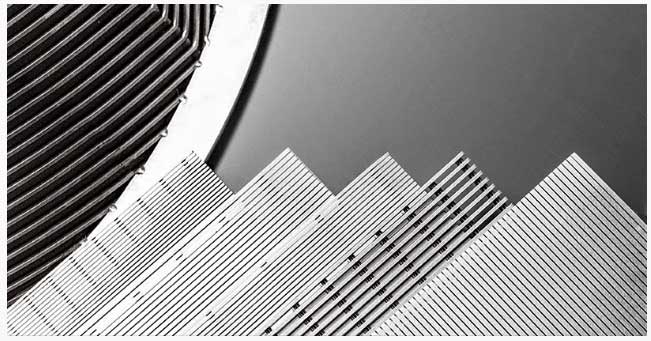We are a professional
Johnson v screen filter manufacturer in China. Our company can provide customization and design services for pulp mills all over the world.

Pulp screening is indispensable process in the pulping process. Johnson screen is one of the important parts to realize pulp screening.
Johnson type pulp screen structure: V-shaped wire + support rod. The V-shaped wire and the support rod are welded together by a girth welding process.
The type of Johnson pulp screen determines the screening effect, screening capacity, and the operation of the screening system.
Johnson Pulp Screen VS Perforated Pulp Screen
There is another screen used for pulp screening-perforated screen.
Perforated screen hole size: 1-2mm
Johnson screen slot size: 0.4-1mm
Therefore, the slotted screen (wedge wire screen) has a higher screening efficiency and the quality of the pulp screened out is better.
(Porous screen)
The sieve plate is divided into smooth sieve plate and wave surface sieve plate. The screening capacity of the smooth screen is affected by the area of the openings. Increasing the screening capacity can be achieved by increasing the aperture or number of holes.
However, the larger pore size will affect the clarity of the good pulp and reduce the screening efficiency. At the same time, the increase in the number of holes and the high density of the holes will weaken the rigidity of the sieve plate.
With a special V-shaped line structure, the Johnson screen adopts a continuous slotted structure to improve the screening capacity under the same screening efficiency.
Although the aperture of the slotted screen is small, the screen adopts a wave surface structure. In addition to the fluid tensile stress and pulsating local stress, the pulp is also affected by the same direction vortex shear stress at the joints, which disperses the fiber network, closer to the fluid characteristics or fluidization, and the fluidized pulp is easier to screen, allowing the pulp to pass through the joints. The flow rate increases.
Although the micro turbulence on the screen seems to increase the width of the screen gap and reduce the screening efficiency of fiber particles, the width of the screen gap can compensate for the drop in screening efficiency by reducing the width of the screen gap.
For the same screening efficiency, the Bo Johnson screen has a higher production capacity than the smooth screen.
For screening operations, since the opening rate of the slotted screen is smaller than that of the perforated screen, the pressure difference increases accordingly, and the pressure pulse generated by the same rotor is larger. In addition, the eddy current effect at the slit is conducive to the passage of long fibers and eliminates the clogging of the slurry at the slit.
Under the same conditions, two corrugated screens with a slot size of 0.254 mm and a diameter of 1.143 mm were studied, and it was found that no matter what kind of pulp was used, the formation of a fiber network could not be observed. Johnson screen, and through the perforated screen you can observe the fiber flocs hanging on the edge of the hole, and it takes several pulses to make them freely enter the mainstream area. Therefore, the use of the
Johnson screen is beneficial to the stability of operation and prevents the pressure screen from clogging.
At the same time, in the screening process of ordinary rotors, there is a thickening phenomenon from the feed end to the discharge end, that is, as the consistency of the feed side of the screen plate gradually increases, resulting in a good concentration of pulp, which makes the screening process in different areas. When the pulp concentration is higher than 1.5%, the fluidization energy consumption increases as the pulp concentration increases. When the pulp concentration is higher than 3%, a high energy input is required.
In fact, due to the thickening phenomenon on the surface of the sieve plate, only 1/3 or 1/2 of the surface of the sieve plate can achieve an effective screening effect. In the lower part of the screen, the power consumption is only used to stir the slurry.
The use of a rotor with a widened action surface eliminates the thickening phenomenon in the screening process, makes the slurry fully fluidized in the screening zone, enhances the suction/pulse effect, and ensures uniform screening conditions on the entire screen surface. The concentration of the good slurry is almost the same as the concentration of the feed slurry and the slurry.
Uniform screening conditions can increase screening concentration. As the sieving concentration increases, the sieving quality and sieving capacity will increase accordingly. At the same time, the high-concentration screening and washing equipment have been improved.
